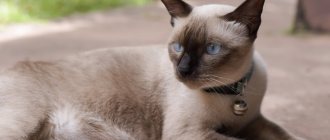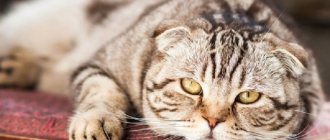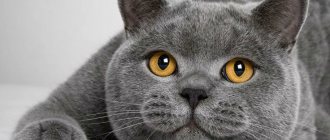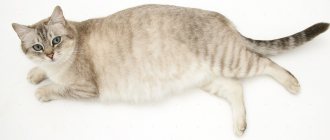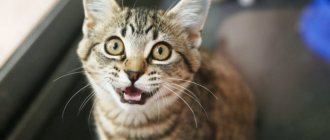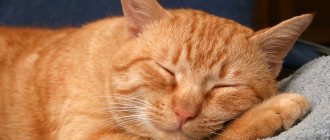Diabetes mellitus in cats is one of the most common diseases of the hormonal system, which is based on a violation of carbohydrate metabolism. The pathology mainly occurs in older animals, more often in neutered cats than in cats. In this article we will talk about why diabetes occurs in cats, why it is dangerous, and how to treat it.
What is diabetes mellitus?
Glucose is the body's fuel and provides energy to the body. Every cell of the body needs it; if it doesn’t receive it, it stops working and dies. Glucose enters the body with food, is processed in the intestines and absorbed into the blood. Then it is picked up by the hormone insulin, which is produced by the pancreas, and carried to the cells, where it binds to their receptors. Through them, insulin transfers glucose to tissues.
If the cell cannot absorb sugar, it remains in the blood and goes into fat reserves. When the body begins to starve and needs glucose, reverse reactions are triggered, during which fat is converted back into fuel.
Diabetes mellitus develops when:
- The pancreas produces too little insulin, and there is not enough of it to provide all cells with glucose. Pathological processes develop in tissues that have not received fuel. They begin to die and cause a malfunction in the body.
- Cell receptors lost sensitivity to insulin, stopped taking glucose from it, and began to starve against the background of high blood sugar.
How long cats with diabetes live depends on the owner. If an animal is treated, it will live a long time. If the disease is ignored, he will die soon.
Treatment
Treatment for type 1 diabetes involves only intravenous insulin. The dosage is determined by the doctor. This requires hospitalization for several days to adjust the dose in accordance with laboratory diagnostic data. After normalization of the pancreas, the dose can be reduced.
At the same time, vitamin therapy is prescribed. Without insulin, death occurs in 80% of cases. Type 2 diabetes can be treated with diet and pills to lower sugar levels (the effectiveness of which remains controversial). Folk remedies for treatment do not give a positive result.
Despite the fact that the dose is initially selected by a doctor, further adjustment is required, sometimes even over a long period of time. You can monitor your blood sugar using urine test strips or a special veterinary glucometer. All this can be purchased at the pharmacy. Normally, there should be no glucose.
A glucometer for animals can be ordered from a veterinary clinic. The doctor must train the owner to use this device.
Hypoglycemia and hyperglycemia
If the insulin dose exceeds the required value, hypoglycemia develops. The condition is characterized by a decrease in blood sugar levels. It manifests itself as anxiety, shortness of breath, and deviations from the normal state of the animal. In rare cases, it is asymptomatic.
If there are signs and measurements show a decrease, then the animal must be given a 40% glucose solution intravenously. You can put food, a piece of sugar or honey in your mouth.
Hyperglycemia is an increase in sugar levels. The cause may be insulin administered at the wrong time. It is necessary to consult a veterinarian regarding further actions.
If episodes of mild hypoglycemia go unnoticed several times, the body may itself increase sugar levels. You should leave the cat at the veterinarian for a while for adjustments.
Types of diabetes
There are 2 types of diabetes mellitus in cats:
- The first type - the cells of the pancreas are destroyed, and it produces insulin in critically small quantities.
- The second type (90% of cases) – body cells lose sensitivity to insulin and stop taking up glucose. In response, the pancreas reduces insulin production, at a certain stage the process becomes irreversible.
Clinically, the forms are difficult to distinguish from each other. The only difference is that type 2 diabetes in cats can be reversed with timely treatment, type 1 diabetes cannot be reversed, it can only be slowed down. If the disease is not treated, the consequences differ little - the pet will face disability and death.
What's the result?
Diabetes in cats is one of the most common metabolic disorders. Diabetes is caused by poor diet and an inactive lifestyle. Diabet is quite easy to recognize: the cat eats more, but at the same time loses weight, drinks a lot and often goes to the litter box.
Feline diabetes can be cured if
- feed your pet healthy food that is low in carbohydrates but rich in animal protein,
- monitor blood glucose levels,
- use insulin in the correct dosage.
Diabetes is preventable. To do this, first of all, you need to provide your pet with a healthy diet that is biologically suitable for him. Since cats are carnivores, a diet based on fresh meat and internal organs is biologically suitable for them. Today, feeding your cat the right food is easy and affordable. See for yourself - try SUPERPET.
Causes of diabetes in cats
Diabetes mellitus in cats is a multifactorial disease, the development of which often involves several causes. Among them:
- Genetic predisposition – Burmese, Siamese, Russian Blue, Norwegian Forest, Abyssinian cats.
- Poor nutrition – a diet with a lot of carbohydrates (added grains, sugar).
- Overweight.
- Sedentary lifestyle.
- Endocrine diseases. First of all, these are pathologies of the pancreas. In 30% of cases, cats with diabetes have acromegaly, a disease of the pituitary gland, which is accompanied by increased production of growth hormone in an adult animal.
- Treatment with glucocorticoids.
- Urinary tract infections and inflammation of the oral cavity can cause diabetes in a cat due to the constant synthesis of stress hormones.
- Age – pathology often occurs in animals after 8 years.
- Gender – Males are more likely to get the disease than male cats.
Causes of the disease
Diabetes, which 20 years ago was considered an exclusively human disease, today is not uncommon among our smaller brothers. The disease develops because specific cells in the pancreas produce little or no insulin.
Factors that provoke the formation of pathology include:
- Unbalanced diet, vitamin deficiency.
- Diseases of the digestive system.
- Chronic pathologies of the gallbladder, kidneys, liver.
- Overeating, excess body weight. Veterinarians usually understand this as a weight that is 1.5-2 kilograms more than normal.
- Genetic predisposition. Taking this fact into account, breeders do not use individuals diagnosed with diabetes in breeding work.
- Viruses, infections that weaken the animal’s immunity.
- Long-term use of hormones, including contraceptives.
- Psycho-emotional stress.
There are first and second types of diabetes mellitus. In the first case, insulin-dependent pathology develops. Destructive changes occurring in the pancreas provoke the breakdown of cells responsible for the production of insulin. This is a dangerous type of pathology; fortunately, it happens to our little brothers in rare cases.
The second type of diabetes is characterized by the fact that beta cells produce insulin, but in very small quantities for the normal functioning of organs and systems. Occurs in 70-80% of all cases. The disease does not require the use of hormones, but specific treatment is necessary. Otherwise, complications in the form of insulin dependence, characteristic of the first type, cannot be avoided.
Diabetes mellitus in cats: symptoms
The kidneys are responsible for removing toxins from the body, incl. excess glucose. Sugar has the ability to attract water. When glucose enters the urine, it takes with it fluid that should have remained in the body. As a result, dehydration develops. Hence, thirst and frequent urination in diabetes mellitus.
Other signs of diabetes in cats:
- Weakness of the hind limbs due to impaired nerve conduction and decreased muscle tone. Hence the plantigrade gait (a healthy cat walks on its toes) and problems with jumping.
- Tendency to bacterial diseases, primarily urinary tract infections.
- Severe hunger - a symptom of diabetes in a cat develops due to the fact that the cells are starving from a lack of glucose.
- Weight loss - the body begins to extract energy from fat reserves and muscles.
Another symptom of diabetes mellitus in cats is the smell of ammonia. It occurs when the liver breaks down fats, extracting ketone bodies, one of the elements of which is acetone. If there is too much of this substance (advanced stage), the animal begins to emit a specific odor. If the owner does not react urgently and does not call a veterinarian, the pet will soon die.
general information
What is diabetes mellitus? This is a disease accompanied by a decrease or complete stop in the production of insulin , although in some cases the synthesis of this substance may increase. But still, a pathology accompanied by its deficiency is considered a “classic”. Why is insulin needed at all, and why is it so important for the body? It's all about the process of digesting food. It involves the “decomposition” of food into its constituent elements: carbohydrates, proteins and lipids. In this process, insulin is responsible for the absorption of glucose coming from the gastrointestinal tract.
What are the causes of the pathology? There are a lot of them, from parasitic infections and poisoning (they hit the pancreas hard) to hormonal disorders.
This substance is a hormone produced in the pancreas . It is necessary so that glucose from the general bloodstream can enter directly into living cells, providing them with nutrition. If there is not enough insulin, the animal's body begins to experience energy hunger. To cover energy needs, it massively switches to fat processing. Since the biochemistry of cats (and humans, by the way) is not adapted to this, a large number of under-oxidized compounds accumulate in the bloodstream and all biological fluids, the most common of which are ketone bodies. In advanced cases, a person located a couple of meters from a sick cat can easily smell the smell of acetone.
Due to the constant feeling of hunger (we remember the lack of energy), the animal eats all the time, but at the same time continues to lose weight catastrophically quickly, since the restoration of fat reserves (in the accumulation of which the same carbohydrates play a huge role) does not occur. During the same period, a large amount of glucose appears in the urine of a sick pet, which directly indicates the presence of diabetes. In addition, a cat with diabetes drinks constantly. He does this so actively that his owners get tired of filling his bowl with water every hour. Thus, the classic symptoms of diabetes in cats are:
- Insatiable hunger.
- Constant weight loss, despite excellent appetite and absence of helminths.
- Increased frequency of urination. The consequences of this, by the way, are serious. The load on the kidneys increases sharply and, if the animal already had some problems with them, kidney failure may develop.
- A sharply increased volume of water consumed by the animal.
Diagnosis of diabetes mellitus in cats
The diagnosis is made based on signs of diabetes in the cat and blood tests:
- For sugar. Glucose in the blood of cats with diabetes increases, but the analysis cannot be used as a reliable diagnosis. The fact is that blood sugar in cats rises quickly under any stress, incl. when visiting a veterinary clinic.
- Fructosamine is a blood protein that binds to glucose, forming a stable compound. In diabetes mellitus, its level rises. The protein circulates in the blood for 2-3 weeks, so recent stress does not affect its concentration.
The value of fructosamine testing is reduced if the cat has hyperthyroidism (overactive thyroid gland). A diseased organ accelerates protein excretion, making it difficult to diagnose diabetes.
Blood and urine tests at home
Measuring blood sugar daily at home, when the cat is calm and relaxed, will help make an accurate diagnosis. Human blood glucose meters can be used for this. Then you need to show the results to the doctor.
A urine test for ketone bodies will help determine the pathology. The diagnostic test can be purchased at a human pharmacy. It will not show the disease at the initial stage, but if the pathology progresses, it will detect ketone bodies.
Symptoms
The initial stage of the disease is asymptomatic. After this, the signs appear quickly and clearly. The following symptoms indicate the possible presence of diabetes:
- changes in taste preferences, behavior;
- general malaise;
- partial refusal of food;
- thirst, frequent urination;
- sudden change in weight;
- disturbances of the nervous system in the final stages (convulsions, muscle twitching).
Laboratory tests reveal the release of sugar into the urine in large quantities and an increase in glucose in the blood.
Diabetic ketoacidosis
Against the background of a chronic lack of insulin, starvation of body tissues develops over a long period of time. If this is accompanied by refusal of food, dehydration, infections, serious illnesses, stress, then a condition arises that requires emergency care.
If the symptoms of the disease are ignored, ketoacidosis develops. It’s hard not to notice it; a significant part of pets come to the veterinarian for the first time with its symptoms, which include:
- slowness and lethargy;
- increased blood glucose;
- extreme thirst;
- smell of fruit or acetone;
- shortness of breath.
The condition requires hospitalization to eliminate symptoms and insulin therapy.
Diabetic nephropathy
The most common symptom is weak limb syndrome. The latter occurs due to damage to the myelin sheath of peripheral nerves due to hyperglycemia. The hind legs become weaker, causing the cat to walk on its entire foot instead of walking on its toes.
Diabetes mellitus in cats: treatment
Timely treatment of diabetes mellitus in cats can, if not reverse, then stop the progression of the disease. If treatment is delayed and the symptoms of diabetes in cats are ignored, the prognosis is poor. Irreversible consequences will begin in the animal’s body, which will lead to disability and death.
If a cat has diabetes mellitus, the first thing to do is listen to the doctor and follow all the recommendations. Main methods of treatment:
- diabetes medications (insulin);
- special diet.
Characteristics of the disease
Diabetes in cats is less common than in some other animals (dogs), but is quite common (one in 400). In terms of the type of changes in the body, the disease is similar to that in humans.
Diabetes is a group of endocrine diseases characterized by insulin deficiency. Accompanied by disorders of all types of metabolism. Even with a nutritious diet, nutrients cannot penetrate the cells. At first, the body tries to compensate for the deficiency, but then the disease wins without treatment, and serious consequences develop.
To maintain life, the animal requires a certain amount of glucose. It enters the body from food, but can only be incorporated into cells in the presence of insulin. Without it, cells suffer, including vital ones.
Juvenile diabetes occurs in kittens, and after 7 years, insulin dependence most often develops. Obesity may also be the cause. Most often, the disease is typical for the following breeds:
- British Shorthair;
- Burmese;
- Oriental Shorthair;
- Maine Coon;
- Abyssinian
Insulin therapy
To treat diabetes in cats, insulin is prescribed to help control blood glucose levels throughout the day. Animal-based insulin is better suited for cats - bovine or pork (Caninsulin).
Synthetic human insulin is absorbed less well and is excreted faster, for example, it lasts not 24 hours, but 12. Among drugs of this type, Levemir and Lantus have shown good results.
How to treat diabetes in cats: injections or tablets
The tablets stimulate the pancreas, improving insulin synthesis, so they are not very effective if the gland is not working (in type 1 pathology). In addition, frequent use of pills can aggravate the condition of the pancreas and damage the liver.
Insulin injections do not give such a reaction. The hormone immediately enters the bloodstream, bypassing the pancreas, causing less damage to the liver. For this reason, doctors recommend insulin injections.
Importance of dosage
Before treating diabetes mellitus in a cat, it is necessary to correctly set the dose of insulin. The difficulty is that when an animal visits a doctor, its blood sugar rises due to stress. Therefore, the dose is prescribed based on measurements taken by the owner at home. If the cat owner is unable to do the test during the day, the dosage is prescribed based on the level of fructosamine in the blood.
In most cats, positive dynamics begin a few days after taking insulin. The recommended dose is 1-2 injections per day.
The importance of monitoring your pet's condition
A sick cat should have its blood and urine glucose levels measured daily. Keep in mind that different brands of insulin affect cats differently. Some medications may last less, while others may last longer.
Monitoring blood glucose levels will help adjust the dose, depending on the type of insulin and the health of the cat. The data obtained during the measurements must be recorded in a diary. It must indicate:
- insulin injection time;
- medication dosage;
- blood and urine sugar levels;
- quantity and time of feeding;
- volume of liquid drunk;
- cat's weight (once a week).
The veterinarian will need this data in order to adjust the treatment regimen in time. You cannot change the dosage yourself if the cat feels better or worse. Moreover, it is forbidden to stop taking insulin without your doctor’s instructions.
Insulin overdose: consequences
If you give your cat too much insulin, his blood glucose levels may drop to critical levels (hypoglycemia). Symptoms:
- weakness and lethargy;
- shiver;
- staggering (drunk gait);
- convulsions;
- loss of consciousness;
- vomit;
- loss of bladder control.
Hypoglycemia is a deadly condition that requires urgent medical attention. To revive your cat while you wait for the doctor, rub honey on her gums.
Description of the disease
Diabetes mellitus is characterized by insufficient production of insulin by the pancreas. This also occurs against the background of hormonal disorders. As a result, the blood sugar level rises and gradually the functioning of all organs and systems fails. Unlike humans, diabetes in cats is divided into three types:
- Insulin dependent. Appears against the background of autoimmune damage to the pancreas. As a result, the gland stops producing insulin. This type of diabetes is rare, incurable, and comes with additional autoimmune problems.
- Insulin independent. With this type, insulin is produced, but the tissues are not sensitive to it. This is the most common form and is diagnosed in 90 percent of cases. Most often, the cause is obesity or age-related changes in the pet.
- Acquired. Develops after diseases that cause disturbances in the functioning of the pancreas or metabolic processes. If the initial disease can be cured, then diabetes will disappear.
Diabetes mellitus in cats can cause serious complications:
- Ketoacidosis. This is a high level of sugar in the blood, when ketone bodies are formed, intoxication of the body appears, shortness of breath, and heart rhythm is disturbed. This can lead to death.
- Diabetic neuropathy. High glucose levels cause damage to the nerve roots in the limbs. The cat's gait changes, and the cat's legs hurt a lot.
- Hypoglycemia (severe decrease in blood glucose). Possible loss of consciousness, muscle tremors, and the onset of coma.
- Diabetic angiopathy (increased vascular permeability). This provokes malnutrition of the limbs, the development of coronary heart disease, and the formation of blood clots.
- Retinopathy. High sugar levels negatively affect vision. The retina begins to deteriorate, its detachment is possible, and after a while - complete blindness.
- Nephropathy. Kidney function is impaired, leading to chronic failure.
- Trophic ulcers. Due to poor circulation, trophic ulcers appear in the paws. More often this is the last stage of the disease.
Complete recovery occurs with the second and third types of diabetes. However, you will have to fully follow the doctors’ orders and follow a diet. Even kittens can get diabetes. Some breeds at risk of predisposition to the disease include Sphynxes, Abyssinians, Siamese, Persians, Burmese, and British Shorthairs.
Nutrition for cats with diabetes
In case of diabetes mellitus, special attention should be paid to nutrition:
- You need to feed your pet 4 times a day at the same time.
- When scheduling feedings and injections, you need to calculate the time when insulin in the blood is at its highest level (usually 3 hours after the injection). Feed as follows: give 2 snacks before the injection, 2 (main feeding) - 3 hours after the injection.
- Give preference to a diet with a low amount of carbohydrates (up to 5%), from which the body extracts glucose.
What to feed a cat with diabetes
The diet should be based on lean meat - beef, lamb, chicken, turkey, which are the main source of protein. Don't forget about vegetables (carrots, cabbage, zucchini), which slow down the absorption of glucose. Salt, spices, pasta, smoked meats, and other food from the master's table are prohibited.
Do not mix:
- natural food with industrial food;
- drying and canned food.
Provide the animal with constant access to water.
Cat food for diabetes
It is better to regulate your cat's glucose with a low-carbohydrate diet, so buy special medicated food. Take a product that belongs to the super-premium and holistic class. Cheaper products are high in carbohydrates (cereals), so they are not suitable for diabetes.
Never buy economy food, especially if your pet is sick. They have an unbalanced composition, a lot of harmful substances, grains that can cause a sharp jump in sugar.
What increases your risk of diabetes?
There are two main factors that increase your risk of diabetes: a high-carbohydrate diet and lack of physical activity.
Wrong diet. Cats are obligate carnivores. Their body is designed in such a way that it receives everything it needs for health from an appropriate diet. What do predators eat? They eat prey, fresh meat.
Cats' bodies cannot produce certain amino acids, such as taurine. Cats get it strictly from food. Taurine is found in meat. There are other amino acids and vitamins that cats need that are found in abundance in fresh meat.
Cereals are a source of carbohydrates. Large amounts of carbohydrates lead to obesity and diabetes. Feeding a diabetic a high-carbohydrate diet will only make the condition worse. Preservatives and other artificial ingredients increase stress on the liver
Insufficient physical activity. When a cat is sedentary, she does not burn the same amount of calories as she does from high-carbohydrate foods.
Cats have a peculiarity: their body breaks down proteins in order to control blood sugar levels. Cats' bodies are not designed to process carbohydrates into energy. Carbohydrates that the body cannot process into energy are converted into fats. Fats are deposited in the cat's body, and the pet gains weight.
Prevention of diabetes
- Monitor your cat's weight and prevent obesity.
- Pay attention to a balanced diet. Remember that the cat is a carnivore, so meat should dominate the menu. Reduce the amount of carbohydrates. If you feed artificial food, it must be of high quality.
- Provide your pet with plenty of exercise, especially if he doesn't leave the house. Play with your pet daily, providing moderate exercise.
- Regularly donate your pet's blood and urine for analysis, if there is a genetic predisposition, the pet is over 7 years old.
- Treat illnesses in a timely manner. If the pathology requires the use of steroids, reduce their amount to a minimum, especially if the pet is obese.
Treatment method and prognosis
Treatment for type 1 and type 2 diabetes will differ. In the first case, insulin therapy (short-acting drugs) is performed. If the disease develops in the second type, the veterinarian prescribes long-acting or intermediate-acting insulin, or replaces hormones with drugs that help lower blood sugar and increase glucose levels.
Compliance with the dosage is the key to successful treatment. Sugar-lowering medications have a lot of side effects.
Insulin is used in the form of injections, which is associated with certain difficulties. Calculating the optimal dose is quite difficult. Measurements are carried out in a veterinary clinic. It will take from 18 hours to 24 hours to establish the glucose level after the administration of an insulin drug.
Next, the veterinarian calculates the time, duration and strength of the hormonal drug. The information obtained helps to correctly draw up an individual regimen according to which the cat will have to take insulin.
As for the prognosis, for diabetes it is cautious or unfavorable (for the first type)
